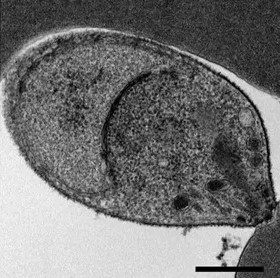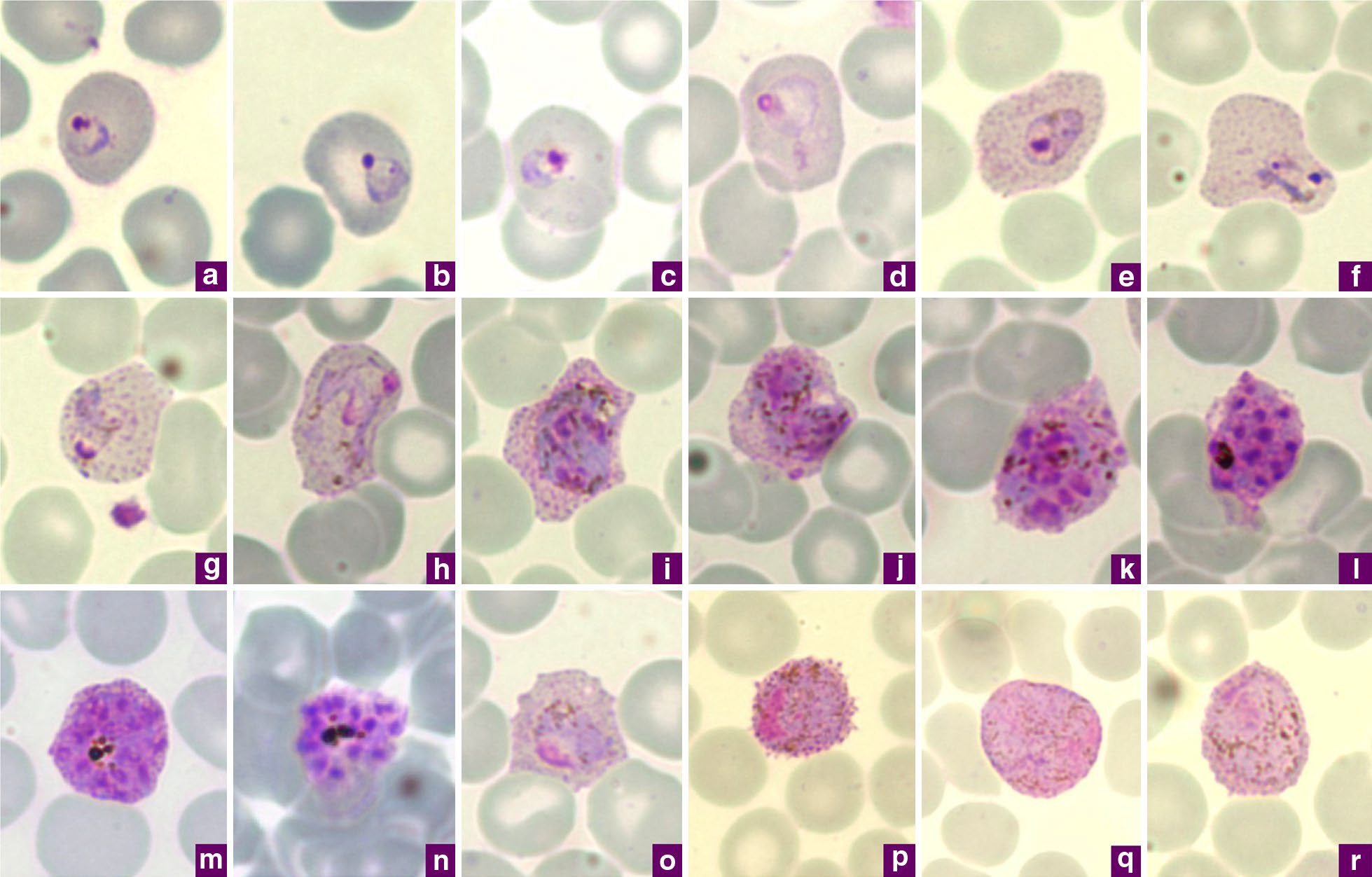|
PfEMP1
''Plasmodium falciparum'' erythrocyte membrane protein 1 (PfEMP1) is a family of proteins present on the membrane surface of red blood cells (RBCs or erythrocytes) that are infected by the malarial parasite ''Plasmodium falciparum''. PfEMP1 is synthesized during the parasite's blood stage (erythrocytic schizogony) inside the RBC, during which the clinical symptoms of falciparum malaria are manifested. Acting as both an antigen and adhesion protein, it is thought to play a key role in the high level of virulence associated with ''P. falciparum''. It was discovered in 1984 when it was reported that infected RBCs had unusually large-sized cell membrane proteins, and these proteins had antibody-binding (antigenic) properties. An elusive protein, its chemical structure and molecular properties were revealed only after a decade, in 1995. It is now established that there is not one but a large family of PfEMP1 proteins, genetically regulated (encoded) by a group of about 60 genes ca ... [...More Info...] [...Related Items...] OR: [Wikipedia] [Google] [Baidu] |
PfEMP1 Diagrammatic Structure
''Plasmodium falciparum'' erythrocyte membrane protein 1 (PfEMP1) is a family of proteins present on the membrane surface of red blood cells (RBCs or erythrocytes) that are infected by the malarial parasite ''Plasmodium falciparum''. PfEMP1 is synthesized during the parasite's blood stage (erythrocytic schizogony) inside the RBC, during which the clinical symptoms of falciparum malaria are manifested. Acting as both an antigen and adhesion protein, it is thought to play a key role in the high level of virulence associated with ''P. falciparum''. It was discovered in 1984 when it was reported that infected RBCs had unusually large-sized cell membrane proteins, and these proteins had antibody-binding (antigenic) properties. An elusive protein, its chemical structure and molecular properties were revealed only after a decade, in 1995. It is now established that there is not one but a large family of PfEMP1 proteins, genetically regulated (encoded) by a group of about 60 genes ... [...More Info...] [...Related Items...] OR: [Wikipedia] [Google] [Baidu] |
Pregnancy-associated Malaria
Pregnancy-associated malaria (PAM) or placental malaria is a presentation of the common illness that is particularly life-threatening to both mother and developing fetus. * PAM is caused primarily by infection with ''Plasmodium falciparum'', the most dangerous of the four species of malaria-causing parasites that infect humans. During pregnancy, a woman faces a much higher risk of contracting malaria and of associated complications. Prevention and treatment of malaria are essential components of prenatal care in areas where the parasite is endemic – tropical and subtropical geographic areas. Placental malaria has also been demonstrated to occur in animal models, including in rodent and non-human primate models. While the average adult citizen of an endemic region possesses some immunity to the parasite, pregnancy causes complications that leave the woman and fetus extremely vulnerable. The parasite interferes with transmission of vital substances through the fetal placenta, often r ... [...More Info...] [...Related Items...] OR: [Wikipedia] [Google] [Baidu] |
Plasmodium Falciparum
''Plasmodium falciparum'' is a unicellular protozoan parasite of humans, and the deadliest species of ''Plasmodium'' that causes malaria in humans. The parasite is transmitted through the bite of a female '' Anopheles'' mosquito and causes the disease's most dangerous form, falciparum malaria. It is responsible for around 50% of all malaria cases. ''P. falciparum'' is therefore regarded as the deadliest parasite in humans. It is also associated with the development of blood cancer (Burkitt's lymphoma) and is classified as a Group 2A (probable) carcinogen. The species originated from the malarial parasite '' Laverania'' found in gorillas, around 10,000 years ago. Alphonse Laveran was the first to identify the parasite in 1880, and named it ''Oscillaria malariae''. Ronald Ross discovered its transmission by mosquito in 1897. Giovanni Battista Grassi elucidated the complete transmission from a female anopheline mosquito to humans in 1898. In 1897, William H. Welch created the n ... [...More Info...] [...Related Items...] OR: [Wikipedia] [Google] [Baidu] |
Antigenic Variation
Antigenic variation or antigenic alteration refers to the mechanism by which an infectious agent such as a protozoan, bacterium or virus alters the proteins or carbohydrates on its surface and thus avoids a host immune response, making it one of the mechanisms of antigenic escape. It is related to phase variation. Antigenic variation not only enables the pathogen to avoid the immune response in its current host, but also allows re-infection of previously infected hosts. Immunity to re-infection is based on recognition of the antigens carried by the pathogen, which are "remembered" by the acquired immune response. If the pathogen's dominant antigen can be altered, the pathogen can then evade the host's acquired immune system. Antigenic variation can occur by altering a variety of surface molecules including proteins and carbohydrates. Antigenic variation can result from gene conversion, site-specific DNA inversions, hypermutation, or recombination of sequence cassettes. The re ... [...More Info...] [...Related Items...] OR: [Wikipedia] [Google] [Baidu] |
Cell Membrane
The cell membrane (also known as the plasma membrane (PM) or cytoplasmic membrane, and historically referred to as the plasmalemma) is a biological membrane that separates and protects the interior of all cells from the outside environment (the extracellular space). The cell membrane consists of a lipid bilayer, made up of two layers of phospholipids with cholesterols (a lipid component) interspersed between them, maintaining appropriate membrane fluidity at various temperatures. The membrane also contains membrane proteins, including integral proteins that span the membrane and serve as membrane transporters, and peripheral proteins that loosely attach to the outer (peripheral) side of the cell membrane, acting as enzymes to facilitate interaction with the cell's environment. Glycolipids embedded in the outer lipid layer serve a similar purpose. The cell membrane controls the movement of substances in and out of cells and organelles, being selectively permeable to ion ... [...More Info...] [...Related Items...] OR: [Wikipedia] [Google] [Baidu] |
Night Monkey
Night monkeys, also known as owl monkeys or douroucoulis (), are nocturnal New World monkeys of the genus ''Aotus'', the only member of the family Aotidae (). The genus comprises eleven species which are found across Panama and much of South America in primary and secondary forests, tropical rainforests and cloud forests up to . Night monkeys have large eyes which improve their vision at night, while their ears are mostly hidden, giving them their name ''Aotus'', meaning "earless". Night monkeys are the only truly nocturnal monkeys with the exception of some cathemeral populations of Azara's night monkey, who have irregular bursts of activity during day and night. They have a varied repertoire of vocalisations and live in small family groups of a mated pair and their immature offspring. Night monkeys have monochromatic vision which improves their ability to detect visual cues at night. Night monkeys are threatened by habitat loss, the pet trade, hunting for bushmeat, and by b ... [...More Info...] [...Related Items...] OR: [Wikipedia] [Google] [Baidu] |
ICAM-1
ICAM-1 (Intercellular Adhesion Molecule 1) also known as CD54 (Cluster of Differentiation 54) is a protein that in humans is encoded by the ''ICAM1'' gene. This gene encodes a cell surface glycoprotein which is typically expressed on endothelial cells and cells of the immune system. It binds to integrins of type CD11a / CD18, or CD11b / CD18 and is also exploited by rhinovirus as a receptor for entry into respiratory epithelium. Structure ICAM-1 is a member of the immunoglobulin superfamily, the superfamily of proteins including antibodies and T-cell receptors. ICAM-1 is a transmembrane protein possessing an amino-terminus extracellular domain, a single transmembrane domain, and a carboxy-terminus cytoplasmic domain. The structure of ICAM-1 is characterized by heavy glycosylation, and the protein’s extracellular domain is composed of multiple loops created by disulfide bridges within the protein. The dominant secondary structure of the protein is the beta sheet, leading resea ... [...More Info...] [...Related Items...] OR: [Wikipedia] [Google] [Baidu] |
Nuclear Magnetic Resonance Spectroscopy Of Proteins
Nuclear magnetic resonance spectroscopy of proteins (usually abbreviated protein NMR) is a field of structural biology in which NMR spectroscopy is used to obtain information about the structure and dynamics of proteins, and also nucleic acids, and their complexes. The field was pioneered by Richard R. Ernst and Kurt Wüthrich at the ETH, and by Ad Bax, Marius Clore, Angela Gronenborn at the NIH, and Gerhard Wagner at Harvard University, among others. Structure determination by NMR spectroscopy usually consists of several phases, each using a separate set of highly specialized techniques. The sample is prepared, measurements are made, interpretive approaches are applied, and a structure is calculated and validated. NMR involves the quantum-mechanical properties of the central core ("nucleus") of the atom. These properties depend on the local molecular environment, and their measurement provides a map of how the atoms are linked chemically, how close they are in space, and how r ... [...More Info...] [...Related Items...] OR: [Wikipedia] [Google] [Baidu] |
Plasmodium Knowlesi
''Plasmodium knowlesi'' is a parasite that causes malaria in humans and other primates. It is found throughout Southeast Asia, and is the most common cause of human malaria in Malaysia. Like other ''Plasmodium'' species, ''P. knowlesi'' has a life cycle that requires infection of both a mosquito and a warm-blooded host. While the natural warm-blooded hosts of ''P. knowlesi'' are likely various Old World monkeys, humans can be infected by ''P. knowlesi'' if they are fed upon by infected mosquitoes. ''P. knowlesi'' is a eukaryote in the phylum Apicomplexa, genus ''Plasmodium'', and subgenus ''Plasmodium''. It is most closely related to the human parasite ''Plasmodium vivax'' as well as other ''Plasmodium'' species that infect non-human primates. Humans infected with ''P. knowlesi'' can develop uncomplicated or severe malaria similar to that caused by ''Plasmodium falciparum''. Diagnosis of ''P. knowlesi'' infection is challenging as ''P. knowlesi'' very closely resembles other spe ... [...More Info...] [...Related Items...] OR: [Wikipedia] [Google] [Baidu] |
Plasmodium Vivax
''Plasmodium vivax'' is a protozoal parasite and a human pathogen. This parasite is the most frequent and widely distributed cause of recurring malaria. Although it is less virulent than '' Plasmodium falciparum'', the deadliest of the five human malaria parasites, ''P. vivax'' malaria infections can lead to severe disease and death, often due to splenomegaly (a pathologically enlarged spleen). ''P. vivax'' is carried by the female '' Anopheles'' mosquito; the males do not bite. Health Epidemiology ''Plasmodium vivax'' is found mainly in Asia, Latin America, and in some parts of Africa. ''P. vivax'' is believed to have originated in Asia, but recent studies have shown that wild chimpanzees and gorillas throughout central Africa are endemically infected with parasites that are closely related to human ''P. vivax.'' These findings indicate that human P. vivax is of African origin. ''Plasmodium vivax'' accounts for 65% of malaria cases in Asia and South America. Unlike ''Pl ... [...More Info...] [...Related Items...] OR: [Wikipedia] [Google] [Baidu] |
Duffy Binding Proteins
In molecular biology, Duffy binding proteins are found in Plasmodium. ''Plasmodium vivax'' and '' Plasmodium knowlesi'' merozoites invade ''Homo sapiens'' erythrocytes that express Duffy blood group surface determinants. The Duffy receptor family is localised in micronemes, an organelle found in all organisms of the phylum Apicomplexa. The presence of duffy-binding-like domains defines the family of erythrocyte binding-like proteins (EBL), a family of cell invasion proteins universal among ''Plasmodium''. These other members may use some other receptor, for example Glycophorin A Glycophorin A (MNS blood group), also known as GYPA, is a protein which in humans is encoded by the ''GYPA'' gene. GYPA has also recently been designated CD235a ( cluster of differentiation 235a). Function Glycophorins A (GYPA; this protein) .... The other universal invasion protein is reticulocyte binding protein homologs. Both families are essential for cell invasion, as they function cooperati ... [...More Info...] [...Related Items...] OR: [Wikipedia] [Google] [Baidu] |






